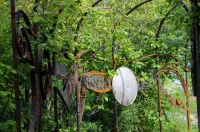
Milwaukee Urban Ecology Blog
This month's native plant is Prairie Alumroot, Heuchera richardsonii. There are about fifty species of Heuchera distributed throughout North America. Heuchera are comonly called Coral Bells or Alumroot and a wide variety of hybrids and cultivars have been bred and selected with colorful or variegated leaves. Prairie alumroot is the only Heuchera native to Wisconsin. A member of the saxifrage family (Saxifragaceae), some of its cousins include genera such as Ribes (gooseberry and current), Astilbe (false spirea), and Tiarella (foamflower).
The best birthday of my life was when my parents let me host my first co-ed party in our backyard. It seemed as if everybody I knew came! My friends, who mostly lived in the city, were especially excited about the bonfire. Living in the country, my family had bonfires several times each summer, but to my city friends this was an entirely novel experience. The huge pile of brush and fallen limbs made a fire so large it hid the people sitting on the other side, adding a sense of intimacy to the conversations taking place around the perimeter. There is something about a bonfire that captures the human imagination. Gazing into the flames while sharing a conversation with…
Living across the street from Riverside Park in the early 80’s during his years as a student at UWM, Eric Crawford had no idea he would travel to another part of the world only to return to these roots some twenty years later. In 2005, the Crawfords were living in the Netherlands, but had returned to Milwaukee for a visit when Eric discovered the Urban Ecology Center. He instantly understood how its presence here would have a deep impact in his former neighborhood.
The Coyote (Canis latrans) is a handsome mammal native to Wisconsin. It has a German sheperd-like appearance, with a yellowish coat and whitish throat and belly. Its back has a darker lateral stripe which extends all the way down to the tail's tip. Proportionally, the coyote's ears are much larger than the similar looking wolf. It is much smaller in size however, weighing between 40 - 100 pounds less.
One species of tree being planted as a part of the Milwaukee Rotary Centennial Arboretum project is the eastern redcedar or Juniperus virginiana. Redcedar is a beautiful coniferous evergreen tree with reddish, vertically fissured bark, interesting awl-and-scale shaped leaves and bluish berry-like cones. It is very important for many different types of wildlife.
Last winter, I had the opportunity to spend a night in a tipi with fellow Urban Ecology Center employee Walter Sams. Below is a passage Walter wrote about our experience. To experience the tipi yourself, check out the Family Program, Family Snowshoe Hike, or join us on Saturday mornings for Stories in the Tipi - Drop In Program.
Do you love Phenology? Whether you answer with an emphatic “Yes!” or you think phenology is a silly word I made up, I hope you’ll become a “Phenology Phan” by the end of this post! At the Urban Ecology Center, we love phenology so much that we formed a phenology team just to help you understand and appreciate phenology. What is Phenology, anyway? Now before I get ahead of myself, let’s take a moment to introduce Phenology and its importance.
We are often asked how we have been able to reach so many people - 20,888 students in 44 Milwaukee schools and a total of 90,000 individuals just last year alone. Our answer? We have a great big group of loyal, generous supporters, that’s how! We invite you to see for yourself. No really, see how many contribted to our success last year!
You may have noticed a new addition to the Urban Ecology Center Riverside Park grounds: A beautiful archway made out of found pieces of iron and steel by blacksmith Nathaniel Reinartz. This arch is located along the northwest corner of the building and covers about fifteen feet of a curving sidewalk. Shrubs and trees will eventually grow through and over the frame. The following was written by Nathaniel about his journey of creating this piece of art for our community.
We’re prescribing outdoor activities to help you connect to nature in Milwaukee! Check out Episode 4 of our Nature Prescriptions video series with Willie Karidis, Branch Manager of Washington Park Branch.
Copyright © 2023 The Urban Ecology Center










